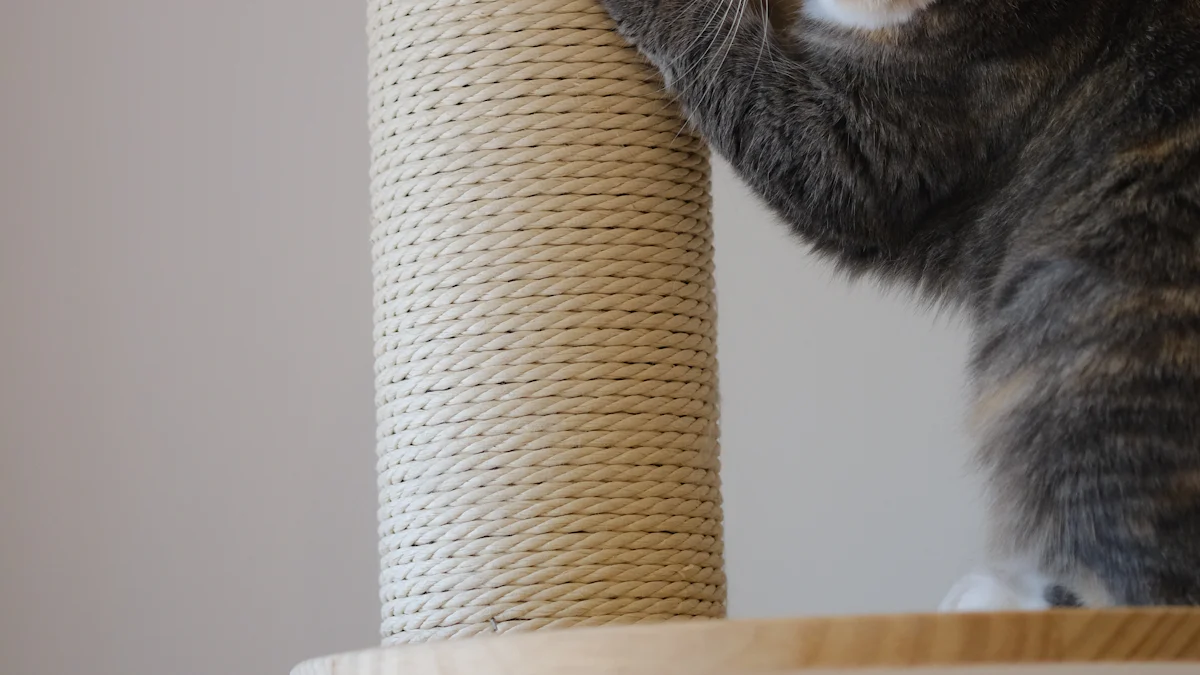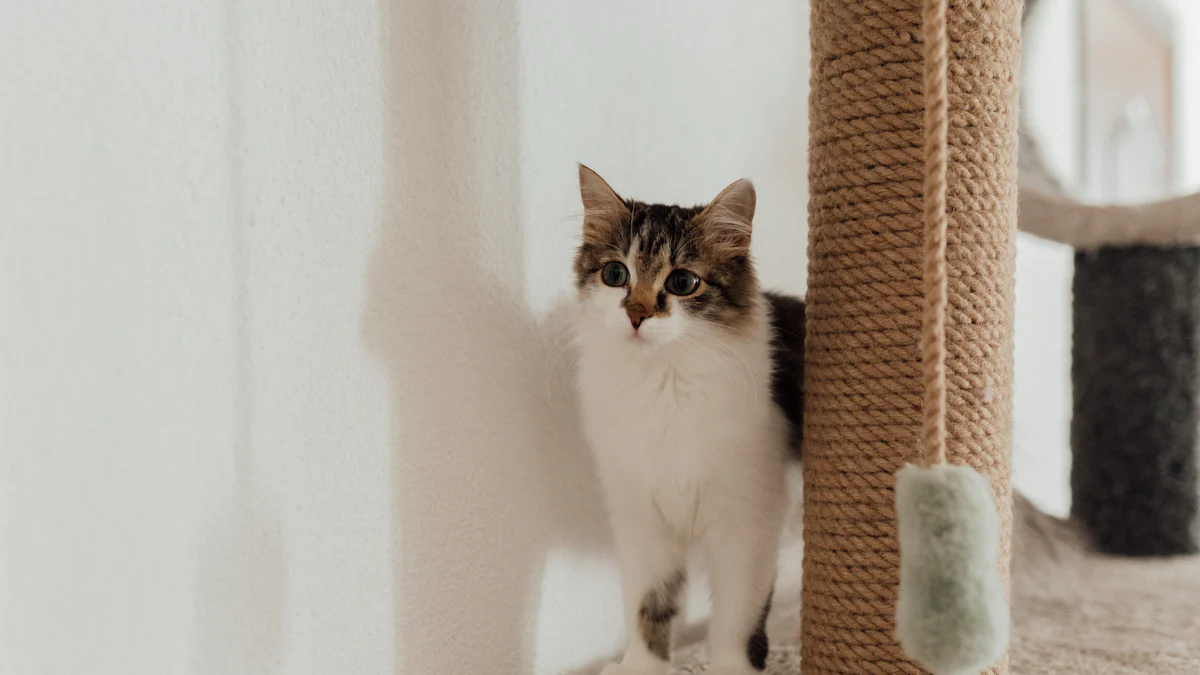Cats love to scratch—it’s in their DNA. But when 58% of cat owners report destructive scratching, it’s clear this natural behavior can cause frustration. A cat scratcher offers a solution. It keeps your furniture safe while giving your pet a healthy outlet. Scratching helps cats stretch, tone muscles, and even relieve stress. With patience and consistency, you can guide your furry friend to use their scratcher effectively, creating a happier home for both of you.
Why Cats Need a Cat Scratcher
Understanding the Natural Instincts of Scratching
Scratching isn’t just a random habit—it’s a vital part of your cat’s daily routine. Cats scratch to keep their claws healthy by shedding the dead outer layers. This process reveals sharp, new claws underneath. Scratching also helps them stretch and flex their muscles, especially after a long nap. It’s like their version of a yoga session!
But there’s more to it. Scratching is how cats mark their territory. When they scratch, they leave behind claw marks and deposit pheromones from the scent glands in their paws. These visual and chemical messages let other animals know, “This is my space.” Scratching can also be a way for your cat to express emotions like excitement or frustration.
By understanding these instincts, you can see why a cat scratcher is essential. It gives your cat a safe and satisfying outlet for these natural behaviors.
Benefits of Scratching for Cats and Owners
A good scratching habit benefits both you and your cat. For your feline friend, scratching keeps their claws in top shape and helps them feel secure in their environment. It’s also a great stress reliever, which can lead to a happier, healthier pet.
For you, a cat scratcher can save your furniture, carpets, and other valuables from damage. When your cat has a designated place to scratch, they’re less likely to target your couch or curtains. Providing a variety of scratching materials can also keep your cat engaged and prevent boredom. Redirecting their natural behavior to an appropriate outlet promotes harmony in your home.
In short, a cat scratcher isn’t just a piece of furniture—it’s a tool for creating a better life for both you and your pet.
Choosing the Perfect Cat Scratcher

Types of Cat Scratchers (Vertical, Horizontal, Angled)
Not all cat scratchers are created equal, and finding the right one depends on your cat’s preferences. Here are some popular types you’ll find in 2025:
-
Scratching Pole: A classic vertical option that lets your cat stretch fully while scratching.
-
Cardboard Scratchers: Lightweight and affordable, these come in both horizontal and angled designs.
-
Scratcher Mat: A flat, horizontal option that’s perfect for cats who love scratching carpets.
-
Scratcher Ramp: Angled scratchers that combine stretching and scratching in one.
-
Scratcher Toys: Interactive options that double as playtime fun.
-
Sisal Scratchers: Durable and satisfying for cats who love a rough texture.
Each type caters to different scratching styles. If your cat loves climbing, a vertical pole might be ideal. For floor scratchers, mats or ramps could be the way to go.
Key Features to Consider (Material, Size, Stability)
When choosing a cat scratcher, focus on materials that appeal to your cat and hold up over time. Cardboard is affordable and has a texture cats love, but it may shed. Sisal is durable and provides a satisfying scratch. Wood and carpet are also great options, with wood offering extra longevity.
Size matters too. A scratcher should be large enough for your cat to stretch fully. Stability is equally important. Wobbly scratchers can scare your cat away, so look for sturdy designs that stay in place during use.
Best Locations to Place a Cat Scratcher
Placement can make or break your cat’s interest in their scratcher. Start by putting it where your cat already scratches, like near furniture or walls they’ve targeted. High-traffic areas work well too, as cats love being where the action is.
You can also place scratchers near their favorite sleeping spots. Cats often scratch after waking up, so having one nearby makes it convenient. If your cat enjoys watching the outdoors, consider placing a scratcher near a window for added entertainment.
Tip: Once your cat starts using the scratcher, you can gradually move it to a more convenient spot for you.
Training Your Cat to Use a Cat Scratcher

Introducing the Cat Scratcher to Your Pet
Getting your cat comfortable with a new cat scratcher takes a little creativity. Start by placing the scratcher in a spot your cat frequents. If they seem hesitant, try laying it on its side to make it less intimidating. You can also sprinkle some catnip on the scratcher to pique their interest.
Toys work wonders too. Play with your cat near the scratcher using a wand toy or something they love. This helps them associate the scratcher with fun. When your cat interacts with it, even if it’s just sniffing, reward them with treats, praise, or gentle petting. Positive experiences will encourage them to return to it.
If your cat scratches elsewhere, gently interrupt them and redirect their attention to the scratcher. Over time, they’ll learn this is the right place to scratch.
Positive Reinforcement Techniques
Cats respond well to positive reinforcement. Reward your cat every time they use the scratcher. Treats are a great motivator, but you can also use praise or playtime as a reward. For example, if your cat scratches the post, say something encouraging like, “Good job!” and give them a treat.
Consistency is key. Reinforce the behavior you want to see every time it happens. Gradually, your cat will associate the scratcher with good things and use it more often.
Redirecting Unwanted Scratching Behavior
If your cat scratches furniture or other surfaces, don’t scold them. Instead, calmly interrupt the behavior and guide them to the cat scratcher. You can do this by gently picking them up and placing them near the scratcher. Use a toy or treat to encourage them to engage with it.
Covering the scratched area with double-sided tape or aluminum foil can also help. Cats dislike these textures and will avoid them. Meanwhile, make the scratcher more appealing by adding catnip or placing it in a prime location. With patience, your cat will shift their focus to the scratcher.
Tip: Always reward your cat when they choose the scratcher over other surfaces. Positive reinforcement works better than punishment.
Overcoming Common Challenges
What to Do If Your Cat Ignores the Cat Scratcher
If your cat seems uninterested in their scratcher, don’t worry—it’s a common issue. Start by making the scratcher more appealing. Sprinkle some catnip on it or use a catnip spray to grab their attention. Cats love familiar scents, so rubbing a soft cloth on their paws and then on the scratcher can help transfer their scent.
Placement matters too. Move the scratcher to a spot your cat already frequents, like near their favorite napping area or a window. If they still ignore it, try experimenting with different types of scratchers. Some cats prefer vertical poles, while others enjoy horizontal mats. Offering a variety of textures, like sisal or cardboard, can also make a difference.
Patience is key. Encourage your cat with treats or praise whenever they show interest in the scratcher. Over time, they’ll associate it with positive experiences.
Preventing Scratching on Furniture or Other Surfaces
To protect your furniture, you need to make it less appealing while promoting the scratcher as the better option. Cover furniture with double-sided tape or plastic sheets—cats dislike these textures. You can also use citrus-based sprays, as most cats avoid the smell.
Regularly trim your cat’s nails to minimize damage. Set up motion-detection air sprays near furniture to deter scratching. At the same time, place the scratcher close to the furniture they target. Reward them with treats or praise when they use the scratcher instead.
Offering multiple scratchers in different locations can help too. Cats love variety, so providing options keeps them engaged and away from your furniture.
Tips to Keep Your Cat Engaged With the Cat Scratcher
Keeping your cat interested in their scratcher requires a little creativity. Rotate scratchers or move them to new spots to keep things fresh. Cats are curious and will often investigate anything that seems new.
Use catnip or toys to make the scratcher more exciting. Dangle a wand toy near it or place a treat on top to encourage interaction. Positive reinforcement works wonders—reward your cat every time they use the scratcher.
If your cat starts scratching elsewhere, gently redirect them to the scratcher. Interrupt the behavior without scolding and guide them to the right spot. Over time, they’ll learn where to scratch and stay engaged with their designated scratcher.
Tip: Choose scratchers made of materials your cat already enjoys scratching, like sisal or cardboard. This ensures they’ll keep coming back for more.
Training your cat to use a scratcher benefits both of you in the long run. Here’s a quick look:
|
Benefit Type |
Description |
|---|---|
|
Physical Benefits |
Keeps claws healthy and improves flexibility. |
|
Mental Benefits |
Reduces boredom and prevents bad behavior. |
|
Stress Relief |
Promotes calmness through natural stress relief. |
|
Behavioral Improvement |
Redirects scratching to appropriate surfaces. |
|
Furniture Protection |
Saves your furniture from damage. |
|
Enhancing Cat-Owner Bond |
Strengthens your relationship through positive reinforcement. |
Stay consistent and patient. Every cat learns at their own pace, but your efforts will lead to a happier pet and a more peaceful home.
FAQ
How long does it take to train a cat to use a scratcher?
It depends on your cat’s personality. Some learn in days, while others take weeks. Stay consistent and patient—it’ll pay off!
Can I use multiple scratchers for one cat?
Absolutely! Cats love variety. Place different types of scratchers around your home to keep your cat engaged and entertained.
What if my cat still scratches furniture after training?
Try covering furniture with double-sided tape or foil. Place a scratcher nearby and reward your cat when they use it. Consistency is key!
Tip: Always praise your cat for good behavior. Positive reinforcement works wonders!
Further Reading: What Every Pet Owner Needs to Know for a Healthier, Happier Pet








